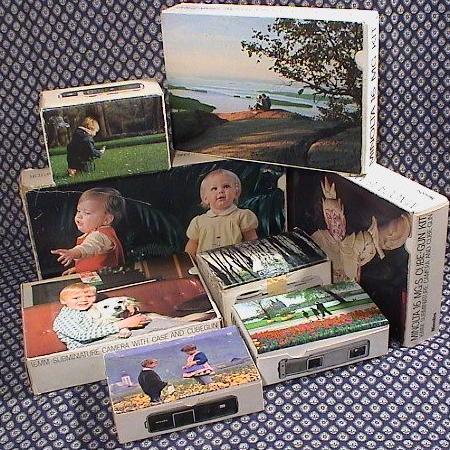The Minolta1 subminiature format was a development of the Mica Automat camera designed by the Konan Institute in 1947. A joint project with Chiyoda Kogaku Seiko Company Limited, which later became Minolta, resulted in the improved Konan 16 Automat. The original Konan cassette is made of metal and has a trap door so that mid-roll change of film is possible without the further loss of a frame. Although this cassette is not compatible with the later Minolta 16 cassette the take up spool works in a similar way.
Konan sold the rights of the Konan 16 Automat II to Chiyoda who redesigned the cassette using a black felt light trap and a double lobe giving it the appearance of a large Minox cassette. The original metal Minolta 16 cassettes where soon replaced by the plastic version. Over the long production of Minolta 16 cameras there were several, near identical versions of the cassette. Cameras where manufactured until 1974 and production of film creased in 1995.
Few manufacturers of subminiature cameras cooperated leading to many different cassette styles. The Minolta 16 cassette was the nearest to a 'standard' as it was also used by Yashica, Kiev, Olympus and Kowa/Bell. Then Kodak got the support of many manufacturers for the 110 format. Minolta 16 cassettes where also made by Yashica, Kiev (original Vega only), a company called FR (which sold the film and offered processing), Ultima and others.
The 1955 Chiyoda 16 Automat was replaced by the Minolta 16 in 1957. It was this model that established Minolta's reputation in subminiature cameras and helped Minolta to become a leading player in the photographic industry.
With the introduction of the Minolta 16 II in 1960 Minolta became the most popular 16mm format. Their popularity, over other 16mm formats, continues as these cameras are still useable. The Minolta cassette uses 16mm film (which is still readily available). As they do not require perforations to advance the film, strips can also be slit from standard 35mm film.

Although Minolta developed the range, adding both simpler designs (16 Ps) and more advanced ones with light meters (16EE, 16 MG), automatic aperture control (16 MG-s) and focusing lens (16 QT) the Minolta 16 II continued production along side the Minolta models of 1972 (see photograph above).
The Minolta 16 MG-s and QT perhaps represent the ultimate in the 16mm format cameras made. They have a 12x17mm frame, share many system accessories and have CdS meters. The fixed focus lens of the MG-s has a large depth of field but has been criticised for lack of an accessory lens to give true infinity sharpness. The f2.8 and 1/30th to 1/500th shutter options make it very flexible in a wide range of lighting conditions. The QT has a focusing lens, f3.5 to f22 but only two shutter speeds of 1/30 and 1/250. See QT v. MG-s - the better lens?.
After 20 years of production why did this popular format disappear? In the early 1970s Kodak, the supplier of all Minolta film, produced a larger 16mm cartridge with film on a paper backing; the 13x17mm 110 format. The paper backing meant that the film was not held flat in the camera as it was used as an indicator of the number of exposures taken, unlike in the Minolta 16 cameras. The Kodak range and most 110 cameras had plastic lens. A few such as the Agfa and the more expensive Rollei, Minolta and Minox versions had quality glass lenses. This larger, yet inferior, format won out by marketing muscle and support from a large range of camera manufacturers.
1961 Accessories
- Accessory shoe clamp for 16 II 17s. 1d.
- Empty film cassette 2s. 4d.
- Black and white film (choice of two) 6s. 4d.
- Reversal film 12s. 8d.
- Filter and Attachment lens set for Minolta 16 £2 7s. 8d.
- Developing tank £2 0s. 9d.
- Paper slide frames (22) 3s. 6d.
- Special Pennant Enlarger (with 25 mm. f/3.5 Rokkor) £18 3s. 4d.
- Negative containers 15s.
- No 0 attachment lens for M16/II 9s. (also No 1 and No 2, also 9s. each)
- Accessory shoe for 16P 13s. 11d.
- Black and white filter set £1 0s. 7d.
- Colour filter set £1 14s. 4d.
- Close-up lens set £1 0s. 7d.
- 35 mm. negative carrier for Pennant 16 enlarger 14s. 6d.
- f/3.5 50 mm. lens for Pennant 16 enlarger £7 0s. 8d.
1967 Accessories
For Minolta 16PS
- Accessory shoe 12s. 8d.
- Black and white filter set £1 3s. 7d.
- Colour filter set £1 19s. 3d.
- Close-up lens set £1 3s. 7d.
- Minolta Baby Flash model III £2 6s. 8d.
For Minolta 16-II
- Accessory shoe clamp 18s. 3d.
- Colour filter set £2 14s. 6d.
- Close-up lenses and yellow filter set £2 14s. 6d.
- Minolta Baby Flash model III £2 6s. 8d.
For all Minolta 16 cameras
- Black and white film (various) 6s. 2d.
- Reversal film 9s. 2d.
- Empty cartridge 2s. 5d.
- Packet 22 Minolta paper slide mounts 4s. 3d.
- Minolta viewer £1 14s. 9d.
- Minolta 16 projector in case £13 13s. 9d.
- Minolta 16 Developing Tank £2 5s. 9d.
- Negative containers (100) £3 1s.
- Minolta 16 enlarger with lens £19 14s. 10d.
Links
A Japanese site http://members.ytv.home.ne.jp/minoxfan/Camera/C-minolta.html provides comparisions of the different Minolta cameras with sample photographs enlarged to show the difference at different distances and in particular at infinity.